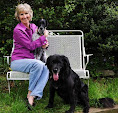
One of the instructions we were given upon taking Tango home was that he needed to wear one of the dreaded (by dogs, that is) E-collars or one of the newer alternatives to keep him from chewing his bandage and licking his incision. The reason veterinarians are so adamant about this is that one of the primary post-surgical complications is infection. And, let's face it, if a dog licks his anus and then a surgical incision, there's a distinct chance that bacteria are going to get transferred.
So the advice--or warning--was merited. Unfortunately, Tango is and always has been a reactive dog that flinches or jumps at sudden sounds, is nervous around unfamiliar people and in novel situations...and sometimes takes a while to recover his equanimity. We have gone to great lengths over the years to help him make his way through life with a minimum of psychic stress. And we didn't want this whole experience to set him back.
So...when he freaked with the E-collar on and did little better with the stiff foam "no bite" collar I'd purchased, we decided, vet's orders or no, we'd have to go without these devices. Which meant that one of us would have to be with Tango pretty much 24/7. So we're taking turns staying home from work...and sleeping on the floor of our first floor sunroom with him. That's because he's not really supposed to go up and down stairs just yet and he's definitely not supposed to jump (or even try) up on our bed.
It actually hasn't been too bad. We've set up a TV, a laptop, his foam bed, the memory foam topper from one of our beds, a pile of quilts, and pillows. And Tango's been a model patient so far. He's checked his bandage a few times, but as soon as we say, "Leave it," he does. He's also allowed us to put ice packs on his knee three times a day for the first three days without complaint. Today we switch to heat pads.







